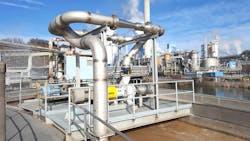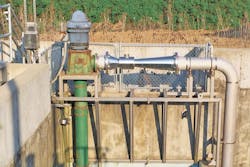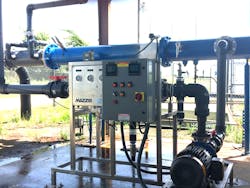The “biomimicry” movement has pervaded many aspects of industry and design. The same concept can easily be applied to industrial and municipal watershed and wastewater management – viewing a site’s water use as a whole and managing the facility as a living, breathing organism. The key word is breathing. By law, industrial water returns must be oxygenated to levels specified by discharge permits. This means the water user must somehow breathe air into the discharge stream. Most natural systems operate at the lowest possible energy cost. In the processing manufacturing world, success is measured by the state of flora and fauna around the discharge point. Fortunately, experienced municipal water managers — experts at aerating both drinking water and wastewater — can shed light on techniques that are suited to industrial applications such as the use of a pipeline flash reactor (PFR) for exceptional aeration results.
Breathe out
Many biomimicry tactics have improved water quality in a many different applications, from constructed wetlands to wood chip biodigesters to well-designed lagoon aerators.
A water utility in northwest Ohio has long used a classic example of mimicry of naturally occurring aeration — a cascade. This wastewater treatment plant’s cascade basin works well at designed flows to achieve the desired dissolved oxygen (DO) levels of 6 milligrams per liter (mg/L) at discharge, but it is quickly flooded when storm events push daily flows through the facility to 26 million gallons per day (mgd) or beyond. This required an addition or modification to this system, one that did not quite impede the natural order of things. To achieve this, a small portion of the flow was diverted to a Venturi injector that draws and mixes atmospheric air easily into the cascade basin system. This aerated sidestream was then mixed into the stormwater flow through a mass transfer multiplier (MTM) nozzle manifold. By using a sidestream Venturi injection/basin nozzle manifold system, utility managers succeeded in raising DO levels from 3.5 mg/L to regulatory targets of 5.6 mg/L, even when storm flows reached 31 mgd – 20 percent higher than the system’s designed peak flow.
The lesson was that sometimes even mimicking natural processes can use enhancement from a system that reproduces a tumbling river’s oxygenation, shear and mixing action in an accelerated way.
In southern Mississippi, water utility managers lacked the space to install a cascade aerator like the system in Ohio. They opted instead for in-line contacting using a PFR, which incorporated MTM nozzles, to create a powerful aeration system that fit on a single skid, with a booster pump, injector and a PFR, merely 6 inches in diameter and 24 inches in length, with little to no pressure loss.
In the PFR system, atmospheric air was drawn into the sidestream flow – just 3 to 5 percent of the total discharge volume – through a Venturi injector. The oxygenated water was directed through the PFR and into the main stream, enhancing the mixing and contacting. The system was engineered and designed with computational fluid dynamics tools. The PFR heightened the shearing and mixing generated by the Venturi injector, maximizing the gas-liquid interface and achieving oxygen transfer efficiency rates of 80 percent. The utility packed a pond’s worth of aeration into just more than 2 feet of pipeline with minimal added energy costs.
When stormwater overwhelms the cascade aeration basin at this Ohio wastewater treatment plant, the silver Venturi injector draws air into a sidestream to aerate the high flows through a manifold. The system has boosted DO levels from 3.5 mg/L to hit regulatory targets of 5.6 mg/L even when storm flows exceeded peak-flow design capacity by 20 percent.
Small footprint
Nature often has a large wetland or a long soil/water interface for natural water treatment, most man-made systems must occupy a smaller footprint. As a result, systems that efficiently draw on the principles of physics, chemistry and biology are often better choices.
In Maryland, another water utility employed a PFR to meet discharge regulations for dissolved oxygen of 10 to 11 mg/L at a plant with a layout that severely limited its options. With inadequate room for conventional aeration waterfalls, bubble diffusers or aeration ponds large enough to handle the facility’s peak flows of 2.9 mgd, managers opted for a PFR connected to an oxygen generator. The utility was able to replace an entire contact basin with a PFR just 3 feet long, driven only by a pump large enough to push the sidestream through the Venturi and PFR.
Into industry
Because of its compact footprint, low power demand, operating advantages and extremely low maintenance, the PFR is finding a home in many industrial environments. In Texas, a power utility put a PFR to work in an existing pipeline. Its plant pumps cooling tower wastewater 2 to 3 miles from a settling pond to discharge points at a local creek or an irrigation system. Pressure in the pipeline ranges from 15 to 30 psi, and the utility managers did not want to interrupt the pressure by introducing a cascade, bubble curtain or other open aeration system between the settling pond and the discharge points. Aerating the lagoon was infeasible because of the high energy demand required for such a large volume of thoroughly deoxygenated water, particularly one so far from the discharge point.
With a 30-square-foot skid, a Texas power utility retrofitted a pipeline with a 42-inch-long Pipeline Flash Reactor (PFR) to oxygenate wastewater without breaking pressure in the line. Treated, aerated wastewater is discharged or land applied 2 to 3 miles away.
A sidestream Venturi injection system combined with a 42-inch-long PFR integrated into the existing pipeline was added to allow the utility to achieve oxygenation levels of 10 to 11 mg/L at the point of injection, which resulted in DO readings of at least the needed 5 mg/L at the point of discharge. The total footprint of the sidestream injection skid was 30 square feet. The elegant simplicity of standalone Venturi injectors can amp up aeration in other systems, too, even without a PFR.
One of the most challenging industrial wastewater environments is a paper mill. At a Virginia plant, a multinational paper company pumped pure oxygen from an O2 generator into a clarifier to oxygenate wastewater at the secondary stage. However, the wastewater system was a bottleneck that limited production – so much so that even producing and pumping concentrated oxygen did not allow the company to treat and discharge its wastewater quickly enough.
Plant managers realized the facility’s inefficient, mechanical, surface-based aspirator transfer system failed to achieve the necessary oxygenation levels, even when the system exceeded the capacity of its on-site cryogenic oxygen plant. The company investigated the installation of Speece cones, whose “bubble swarm” concept would have deployed its oxygen resources effectively, but they turned out to be too expensive.
A manifold of Venturi injectors drawing oxygen from the generator into the wastewater stream that entered the clarifier proved to be more compact and efficient. Compared to the original aspirator contacting system, the manifold installation reduced the oxygen need by maximizing mass transfer in the 44 mgd wastewater flow by 35 to 40 percent while lowering energy costs. It provided the necessary boost to bring the system back into balance, allowing the plant to maintain regulatory compliance.
One water
In a natural watershed, all water is unified. The plants and animals do not differentiate between freshwater and waste streams in a pond or wetland; one organism’s waste is another’s vital resource. This is another critical lesson we can apply to industrial watersheds. Too often, we think of water in binary terms – it comes in as a clean resource and we send it out as treated wastewater.
What happens when we look at water as a resource at each system stage? What can we heat or cool, lubricate, clean, or irrigate before we commit the time, space, energy and equipment to treating it? Calculating these values in terms of the resources they replace or the cost of treatment, we could make more rational, cost-effective decisions. With a clearer sense of water’s value and a view of their place in an industrial watershed, water professionals can learn from man and nature to more efficiently manage this precious resource.
Jim Lauria is vice president of sales and marketing for Mazzei Injector Company LLC, a fluid design company that manufactures mixing and contacting systems. He holds a Bachelor of Chemical Engineering degree and has more than 20 years of global water treatment experience. He may be reached at [email protected].



